Flag of Lebanon
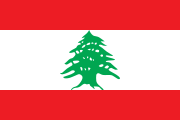 |
|
| Use | National flag and ensign |
|---|---|
| Proportion | 2:3 |
| Adopted | December 7, 1943 |
| Design | Two horizontal red stripes enveloping a horizontal white stripe, with green cedar in the middle |
The flag of Lebanon (Arabic: علم لبنان) is formed of two horizontal red stripes enveloping a horizontal white stripe. The white stripe is to be two times a red one (ratio 1:2:1)—a Spanish fess. The green cedar in the middle touches each of the red stripes and its width is one third of the width of the flag.[1]
Contents |
Symbolism
It was designed to be a neutral flag, not allied to any one of Lebanon's religious groups. The red stripes symbolize the pure blood shed in the aim of liberation. The white stripe symbolizes peace, and the white snow covering Lebanon's mountains. The green cedar (Arz) (Species: Cedrus libani or Lebanon Cedar) symbolizes immortality and steadiness.[2]
This cedar is referenced many times in the Bible: "The righteous flourish like the palm tree, and grow like a cedar in Lebanon" (Psalms 92:12).[3] There is also some reference in W. Smith's 1980 book on the colours: "The red and white colours are those associated, respectively, with the Qaysites and Yemenites, opposing clans that divided Lebanese society between 634 and 1711 AD". However, that explanation is poorly known (not to mention quite unheard of) in the Lebanese tradition.[4]
Red is thought to be for the color of the uniforms worn by the Lebanese Legion during World War I. Officially the red is said to represent the people of Lebanon's sacrifice during the struggle for independence, and white represents purity and peace. Although the flag has existed only for half a century, the tree at the center of the flag – the Cedar of Lebanon – has been an emblem of the country since the time of King Solomon, almost 2,000 years ago. Specifically, the cedar is the symbol of the country's Maronite Christian community. It first appeared on a flag in 1861 when Lebanon was part of the Ottoman Empire. Soon after its collapse, the country became mandated to France and its flag was a French Tricolore, with the Cedar of Lebanon in the white band of the flag. The cedar symbolizes happiness and prosperity for the country.
It is a common mistake to draw the branches of the cedar and the tree trunk in brown or black. Nevertheless the mistake could be seen as unconstitutional. The cedar should be fully green regarding the provisions in the Constitution.[2]
History
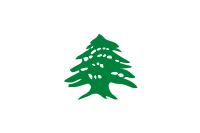
Through history, Lebanon, or at least its region, had taken the flag of the people who occupied it (Mamluk, Ottoman Empire)
French Mandate of Lebanon
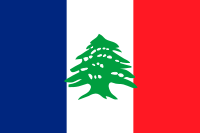
During the French Mandate of Lebanon, the Lebanese flag was designed by the president of the Lebanese Renaissance Movement, the late Naoum Mukarzel. It was similar to the tricolour flag of France but with a Cedar in the middle.
Lebanese Republic
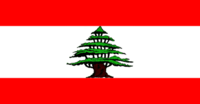
The present Lebanese flag was adopted just prior to independence from France in 1943. Seeking for independence, the actual flag was first drawn by member of parliament Henri Pharaon in the Chamber of deputies Saeb Salam's house in Mousaitbeh by the deputies of the Lebanese parliament. It was adopted on December 7, 1943, during a meeting in the parliament, where the article 5 in the Lebanese constitution was modified.
One theory is that since Henri Pharaon was a long-time consul in Vienna, Austria and was an avid friend and founder of the "Austro-Lebanese Association of Friendship", the colors could have been inspired by the red-white-red Flag of Austria. The Austrian flag is one of the oldest in the world, dating to the 13th century when it first probably appeared after the Siege of Acre during the Third Crusade.
Gallery of Historic Flags of Lebanon
The following is a list of historic flags used in Lebanon[5]
 Variant, used by a portion of Lebanese nationals |
Flag as drawn and approved by the members of the parliament during the declaration of independence in 1943 |
 Flag of the State of Greater Lebanon during the French mandate 1920-1943 |
 Flag of the State of Greater Lebanon during the French mandate 1920-1943 (Variant) |
 Flag of the State of Greater Lebanon during the French mandate 1920-1943 (Variant) |
 Flag of the French Mandate of Syria at the beginning of the French mandate 1920 |
 Flag during the short lived Kingdom of Syria from March 8th to July 24th 1920 |
 Flag during the short lived Kingdom of Syria from March 8th to July 24th 1920 (variant) |
 Flag used in the post WWI under the Arab Administration 1918-1920 |
 Flag used unofficially from 1848 until the French Mandate |
 Flag used in Deir El Qamar, Capital of the Maanid and early Chehab emirs 1830 |
 Flag of the Chehab Emirate 1697-1842 |
 Flag under the Mamluk Sultunate 1250-1517 |
 Flag under the Mamluk Sultunate 1250-1517(variant) |
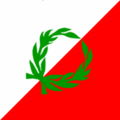 Flag of the Maanid Emirate 1119-1697 |
 Feudal Flag of the Jumblat clan during Middle Ages |
 Feudal Flag of the Abu Kanad clan during Middle Ages |
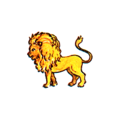 Feudal Flag of the Lamaite princes during Middle Ages |
 Rebels Flag during the Merdai era (Yemenites) |
 National Maanid Flag |
 Rebels' Flag during Prince Ibrahim Era |
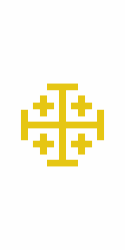 Kingdom of Jerusalem Flag 1099-1291 |
 Flag under the Abbasid Caliphate 750-1258 |
 Tanukh Flag 200 AD - 400 AD |
 Flag used during Phoenician era 3000 BC - 200 AD |
See also
- Coat of arms of Lebanon
Notes
- ↑ The description of the flag is cited in the Lebanese Constitution, Chapter 1, Article 5.
- ↑ 2.0 2.1 "The symbols of the republic". Lebanese Presidency Official Site. http://www.presidency.gov.lb/presidency/symbols/flag/flag.htm. Retrieved 2008-04-16.
- ↑ Psalm 92:12 The righteous man will flourish like the palm tree, He
- ↑ "Flag of Lebanon". Encyclopædia Britannica. http://www.britannica.com/dday/print?articleId=93896&fullArticle=true&tocId=9093896. Retrieved 2008-04-16.
- ↑ Historical Flags (Lebanon)
External links
- Lebanon at Flags of the World
- Lebanese Flag Accurate, high quality, & high resolution flags of Lebanon.
|
||||||||
|
||||||||||||||
|
||||||||